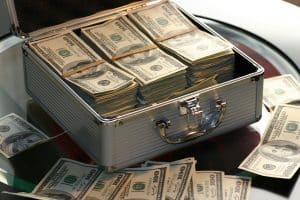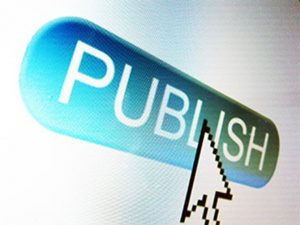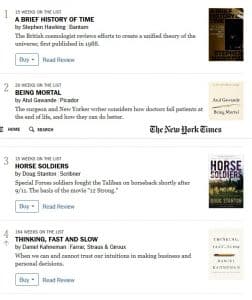The Numbers Behind the Words: Can You Make Money Writing Non-Fiction Books?
August 21, 2020
We all know an awful lot about something. It’s just the way people are.
Your area of expertise might be something useful, like knowing how to fix cars, or it might be something less tangible, say, an obscene amount of knowledge about cartoons from the late 1970s to the early 1980s (ruh roh, Raggy!).
Whatever the case may be, chances are that people come to you from time to time to ask your opinion about something related to your area of expertise.
Even folks who wouldn’t necessarily call themselves an authority in anything have this happen.
For some, once they hit a certain level of knowledge on a topic, the logical next step is to sit down and start writing about it.
Writing a non-fiction book can be a great way to expand on your knowledge of something and, best of all, show off how much you know about something (in a good way, not a braggy way).
Even in the digital age, when everyone is jumping on the internet to write blogs about what they know, we’re still seeing a lot of books hitting the market. In 2019 alone, more than 650 million books were sold!
But, even with all those books entering the market every year, how possible is it to actually make a living as a non-fiction writer?
Is it still possible to dedicate your life to writing about topics that you care about? Or do you have to live out your dream by supplementing your writing with a job at the mall?
Let's Take a Closer Look at the Money

The traditional book route
1. Getting a book deal.
For most of us, when we dream about writing a book, we dream about just that: a book.
Dust covers, author photos, hardcovers (and soft) and, paper pages.
Glorious, glorious pages.
It’s only natural that this is the first thing that comes to mind because, despite ebooks gaining in popularity in the last 10 or so years, people still love to get their hands on a physical book.
There’s just something about them that drives us to them.
Writers are no different. If you’ve had a dream of writing for any amount of time at all, you’ve probably spent most of that time dreaming about holding a real book with your name all over the cover.
So you decide to go for it.
The first thing that’s going to happen when you manage to snag yourself a book deal is getting an advance (I’ve cut quite a few steps out here, like finding an agent and prepping your submission, but we’re talkin’ money here).
An advance is a kind of loan that publishers use to pay you up front.
In the non-fiction world, you’re typically looking at anywhere from $5,000 to $20,000 for your first book.
As the link suggests, this can vary a lot depending on things like your level of authority, any audience you may have, and the timeliness of the topic.
Advances are usually paid out in chunks, typically in thirds.
You get the first third when you sign the contract, the second third when you turn in the manuscript, and the final third when the book is published.
These advances are then paid out by book sales and, if you’re lucky enough to pay out your advance, you start collecting royalties.
Royalties are the percentage of each book sale that an author gets.
This can range from 7.5% to 15% of the retail price depending on the kind of book that’s being sold (hardcover vs. mass market paperback vs. trade paperback vs. ebook, etc.) and the publisher.
Since all deals tend to be different, let’s say you’ve just released a book that sells for $30 as a hardcover.
If your royalty is 10%, you get $3 for each book sold.
Now, let’s also say you managed to secure a $15,000 advance.
That means you’d have to sell 5,000 copies of your book to earn out your advance.
Any books that you sell after that 5,000th book means money in the bank for you.
2. Writing your book.
OK. So, you’ve signed the contract and collected you first payment. Now what?
Well, now you write.
That initial chunk of the advance is meant to help you get through the writing phase. A non-fiction book can be a big, long, project, and it helps to have a bit of financial freedom from your job to get it done.
It’s probably going to take you anywhere from six months to a year to complete your book, depending on how much research you’ve done in advance, how well you know the source material and similar factors.
The first third of your advance is for this section.
Then there’s the editing phase.
You’re looking at another couple of months to get through this. That’s where the second third of your money goes.
3. Promotion time!
The final third of your money comes when you turn in the finished copy of your book.
Once you’ve gotten your book done and publishing dates have been set, it’s promotion time.
Yup, even if you’re with the bigger publishers, writers still end up doing the bulk of the promo work.
This is because with close to a quarter million books hitting the shelves every year, there just aren’t enough marketing people out there.
That, and frankly, no one knows your book like you do.
If you want your book to be successful, you’re going to need to market your book until you’re sick of it.
And, you’re going to have to do it every chance you get.
You’ll talk about it on social media, you’ll tell your friends, their friends, your family, their friends… Chances are, everyone who is even slightly connected to you is going to know that you have a book coming out.
And, if you’re lucky, most of them will buy it.

Going the DIY route
It wasn’t that long ago that self-publishing was seen as a bit of a fool’s errand.
Sure, you might have made some money, but the success stories were few and far between.
Flash forward to today where self-published books have been making great strides in terms of quality, being taken serious by both writers and the general public and, best of all, people have been making money doing this.
Online retailers like Amazon have made it beyond simple to self-publish a book and sell it on their site, thanks to things like Kindle Direct publishing.
Unlike the traditional publishing world, you don’t get any money up front when you go the self-publishing route.
In fact, all the associated costs of putting the book together—the ones that would have been covered by the publisher in the traditional publishing market—get covered by you.
That means you pay the editors, book designers, cover designers and all that.
All this can be done for just a few hundred with turnkey publishing sites, or for tens of thousands with elite editing and publishing services.
The more you put in at this stage, the better the chances of your book looking like it was put out by professionals and not just someone who knows Photoshop (because your book will have been put together by professionals).
But, once that’s taken care of, you get a bigger piece of the pie on the sales end.
Instead of only getting the industry standard of anywhere from 7.5% to 15%, you keep a much higher percentage after the retailer takes their cut.
In the case of Amazon Kindle Direct, you get either 35% or 70% of a sale, depending on the circumstances.
That bigger chunk of sales that you take home is going to help you pay off what was basically your advance faster (the money you spent putting your book together) and will help you start making some money.

What does success look like?
Best seller status is something that most writers dream of at some point or another.
It’s kind of the old school version of going viral, only with books.
Best seller lists are, as you might guess, put together based on how books are selling.
They’re calculated on a weekly basis and the criteria, data gathered, and stores used to calculate these lists tend to vary widely from list to list.
The New York Times, for example, puts together their list based on the sales from vendors across the United States, although the list is reported confidentially, so no one ever really knows for sure which stores are doing the reporting.
USA Today, on the other hand, tells you some of the vendors they rely on for their list.
And those are the easy ones to figure out.
Just look at how Amazon figures out their numbers here.
Go on. I’ll wait for a minute.
Had a look? Great. You probably noticed that for every explanation they have, there were exceptions.
The trouble with bestseller lists is, among other things, is there’s no guaranteeing anything about them.
You could have the best book in the world out there, and your book could still struggle to get on the list because of something, anything that happened in the world that week.
Take a look at the list below (from The New York Times non-fiction list), for example.
Notice that the bestselling non-fiction paper is Steven Hawking’s A Brief History of Time.
This list, as it happens, represents the week after Hawking’s death.
Things like this can throw off the momentum of just about any book, regardless of how well it has been doing in the previous week.

According to Bridget Marmion, former senior vice president of marketing for publishing houses such as Fararr, Straus and Giroux, and Random House, and founder of Your Expert Nation, being on a best seller list is always nice, but it should never be your goal.
It’s mostly because of the number of factors at play when determining the lists.
If a movie adaptation of a book happens to be coming out the same week as your book (this can happen in non-fiction as easily as it could happen in fiction, think of movies like Eat Pray Love and Wild), it’ll be a struggle to get your book on the list.
Having said that, if you can get yourself on a best seller list, it can help.
“Being on a list that is important to your audience would move the sales needle, if you’re on it for a few weeks,” says Marmion.
She adds that this can also help you with your next book, as traditional publishers are more likely to take a chance on someone whose book has been on a best seller list.
The burning question (I’m sure) is just how many books does it take to crack a best seller list?
Well, that answer, I’m afraid, is complicated.
It depends on the list, the time of year, what else is happening in the world and a host of other things.
For traditional lists like The New York Times or USA Today, those numbers look to be anywhere from 3,000 copies to 5,000 copies sold.
Getting into the Amazon Top 5 would require sales of about 300 books a day.
And, to really complicate things, it’s entirely possible to get on an Amazon best seller list by selling very few books because you’re in a category that’s so specific you’re essentially on your own.
Just check out the example located towards the end here, which hit the best seller list with only three books sold.
These numbers aren’t high, but most books, especially debut books, don’t even come close to selling that many books.
Few books earn out their advances, which means they sell enough books to pay off the advance, and the numbers for average books sold can be as little as 250 books (although like everything in the publishing industry, there’s a lot of factors at play in figuring out exact numbers like that).

So...now you've got a book out
Congrats!
It’s a great feeling being able to hold a book with your name on the front of it (trust me, I know).
At this point, you need to decide what it is you want to do with that book.
If you want that book to make money, you need to market it.
In fact, you should have started marketing it, like, six months before it came out.
Unless you’re an established name in your industry, traditional publishing houses aren’t going to put too much effort into marketing your book.
With the sheer number of books hitting the shelves every year, publishers just don’t have the time or resources to do that.
You have to be prepared to hustle and self-promote your book to make it work.
If you have any authors, fiction or non-fiction, on your social media feeds, you’ve seen them doing this before.
It takes a lot of time and energy to make it work, but if you want your book to succeed, you have to be ready.
As if this didn’t seem daunting enough, according to Nick Morgan, who helps thought leaders and public speakers publish books (among other things), most publishers give a book about two weeks to make money.
After that, a book gets remaindered, which is when a book is sent off to discount books stores or remainder bins in book stores.
That means you really have to hit the ground running with your book if you hope to get a second book, or even earn back your advance.
This can leave a lot of authors feeling betrayed, especially when you add the fact that publishers don’t really promote books enough to help you succeed.
Luckily, all is not lost.
It’s possible to use your book to help you earn money doing something else. The trick, according to Morgan, is figuring out what that something else is.
Having a book (or two) to your name is never a bad thing.
Among other things, a book helps people understand that you really know what you’re talking about, and solidifies your status as an expert in your field.
Not just anyone can sit down and write a book. It takes a solid understanding and a very firm grasp of your topic to produce a quality book.
A book helps you stake a claim as someone who is an authority on a topic.
This can be especially helpful early on in your career, when people often struggle to be taken seriously and even to make a good living.
As Morgan puts it, “You have to establish expertise via a book.” From there, you can leverage that book to grow your career.
This extra level of authority helps you almost regardless of what you do.
People are more likely to trust a vet who’s written about a pet care over one who hasn’t.
A motivational speaker who has a book is not only going to be able to charge more because of their book, but people are going to listen more. Same if you’re a journalist or a politician or an athlete.
All this means is that you have to know going in what you hope you get out of your book.
If you’re going into it expecting success and sacks full of money to start arriving at your door on the day it’s published, you’re probably going to end up disappointed.
But, if you’re willing to do the work that needs to be done (like the marketing) or you’re writing a book to help bolster some other aspect of your career, then your book is going to help you make money.
It might not be tons of money, not to start, but, like all things publishing, if you’re willing to play the long game and build up a following using that first book, it’s going to get easier and easier to make money with each subsequent book.






























